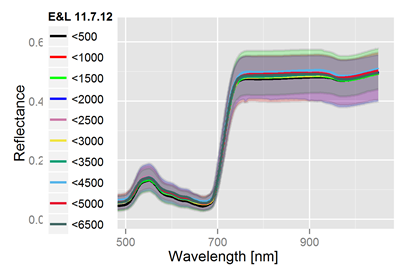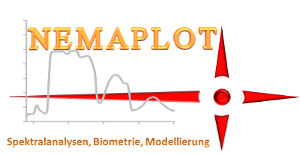Quantifying continuous traits based on hyperspectral information
Extensions: As we applying a discriminant analyses on discrete or qualitative traits, we introduce an alternative solution multivariate procedure for continuous or quantitative data. Taking Heterodera schachtii as an example, we introduce an approach, how the information of non-invasive sensor technology taken from sugar beet canopies provide an estimate of the sub-soil/root living sugar beet nematode population, hence no qualitative parameter, but a quantitative data, here eggs & larvae/100 ml soil (E&L). The combination of the parameter estimates of the Weibull model and a "general linear model" results in:

The searched data E&L (or 'EuL'), or any other target, is the sum product of the non-linear parameters of the Weibull model (Wi) and a linear constant Xi plus the constant C
Applying the introduced functions to nematode field data with the susceptible sugar beet variety Beretta results in a common model, which provides information about the underlying nematode population density based on hyperspectral signal taken from above soil canopies (left figure).


Despite the high correlation and no systematical deviance from the 1:1 proportion of predicted and observed nematode density, is a feasability study only. The common linear model is not stable. The estimated parameters are not transferable to other years or even days within the season. And it worked only with susceptible varienties with that precision, but not with tolerant/resistant varieties. It was a big surprise to achieve that accuracy at the first step. More explanations are required: the observed nematode numbers have been derived from labour intensive soil samples before planting. The hyperspectral measurements took place sometime during the season, while both host and nematode were growing in complex and interactive manners. Finally, such experimental data are not available in normal conditions to achieve a sufficient sample size for the parameter estimation.
 Evaluation reinvented
Evaluation reinvented
